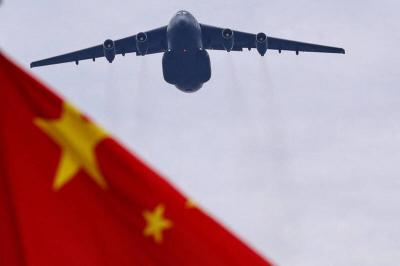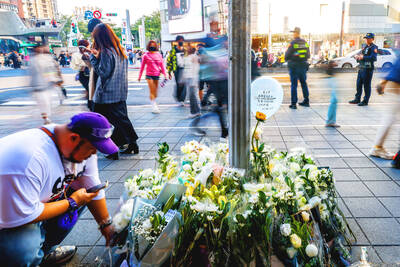On Friday, Green Island Human Rights Memorial Park will debut a series of events to mark the 60th anniversary of the declaration of martial law, during which an updated name-list of White Terror victims will be unveiled.
The memorial park’s administration said a total of 8,296 names would be disclosed, which is seven times the number disclosed in 1999 by the Bo Yang Human Rights Educational Foundation. The park’s administration entrusted Taiwan Art-in Design with collecting and verifying the information concerning White Terror victims.
Taiwan Art-in Design president Ronald Tsao (曹欽榮), who is also a board member of the Deng Liberty Foundation and the Chen Wen-chen Memorial Foundation, said the new list covers a time span stretching from just after the 228 Incident in 1947 to 1989, two years after Marial Law was lifted in 1987.
The 228 Incident refers to the military crackdown by the then-Chinese Nationalist Party (KMT) administration on civilian protesters that started on Feb. 27, 1947. Historians estimate that around 30,000 people were killed.
What followed the 228 massacre has been labeled the White Terror, during which numerous people were arrested. Many lost their lives after the declaration of martial law.
Most of the victims were prominent Taiwanese, including lawyers, prosecutors, doctors, professors and media workers. There is no official tally of the number of people who were jailed, went missing or were killed.
“The sources for such a long list came from several places, including the National Archives Administration, household registration offices, published or unpublished memoirs or oral accounts from White Terror victims, the disciplinary facility for political prisoners in Tucheng (土城), as well as those that have already been compensated by the government for mistreatment during the Martial Law period,” Tsao said.
Tsao said some family members were able to find their fathers or other relatives when a list of “White Terror” victims was released two years ago.
However, family members cannot simply use the list as a way to demand compensation from the government, Tsao said, adding that they must follow the government’s procedures.
Recounting the difficulties in tracking down White Terror victims, Tsao said his research team had asked to view more than 100,000 digital files and hard copies of information from the National Archives Administration. The team spent about 10 years tracing the victims and comparing the information, he said.
“Some of the victims shared the same name,” Tsao said. “Some of the victims’ court rulings were lost and others did not even have rulings in their files.”
Tsao said that of the 1,061 people on the name-list who were executed, 63 percent were Taiwanese, while 35 percent were from China. Seventy-six percent of the victims were between 20 and 40 years of age. The youngest of the executed was 19 years old and the oldest was 65, he said.
Those who were executed were from all walks of life, including farmers, vendors, coal miners, small shop owners, sailors, reporters, inspectors of the Taiwan Railway Administration, students, school principles and military officials, he said.
Tsao said the intelligence agency even used daughters of the victims to solicit information from Chinese spies.
Names and photos of the updated list will be gradually posted online at http://2009greenisland.blogspot.com/.

Beijing could eventually see a full amphibious invasion of Taiwan as the only "prudent" way to bring about unification, the US Department of Defense said in a newly released annual report to Congress. The Pentagon's "Annual Report to Congress: Military and Security Developments Involving the People's Republic of China 2025," was in many ways similar to last year’s report but reorganized the analysis of the options China has to take over Taiwan. Generally, according to the report, Chinese leaders view the People's Liberation Army's (PLA) capabilities for a Taiwan campaign as improving, but they remain uncertain about its readiness to successfully seize

HORROR STORIES: One victim recounted not realizing they had been stabbed and seeing people bleeding, while another recalled breaking down in tears after fleeing A man on Friday died after he tried to fight the knife-wielding suspect who went on a stabbing spree near two of Taipei’s busiest metro stations, Taipei Mayor Chiang Wan-an (蔣萬安) said. The 57-year-old man, identified by his family name, Yu (余), encountered the suspect at Exit M7 of Taipei Main Station and immediately tried to stop him, but was fatally wounded and later died, Chiang said, calling the incident “heartbreaking.” Yu’s family would receive at least NT$5 million (US$158,584) in compensation through the Taipei Rapid Transit Corp’s (TRTC) insurance coverage, he said after convening an emergency security response meeting yesterday morning. National

Taiwan has overtaken South Korea this year in per capita income for the first time in 23 years, IMF data showed. Per capita income is a nation’s GDP divided by the total population, used to compare average wealth levels across countries. Taiwan also beat Japan this year on per capita income, after surpassing it for the first time last year, US magazine Newsweek reported yesterday. Across Asia, Taiwan ranked fourth for per capita income at US$37,827 this year due to sustained economic growth, the report said. In the top three spots were Singapore, Macau and Hong Kong, it said. South

PLANNED: The suspect visited the crime scene before the killings, seeking information on how to access the roof, and had extensively researched a 2014 stabbing incident The suspect in a stabbing attack that killed three people and injured 11 in Taipei on Friday had planned the assault and set fires at other locations earlier in the day, law enforcement officials said yesterday. National Police Agency (NPA) Director-General Chang Jung-hsin (張榮興) said the suspect, a 27-year-old man named Chang Wen (張文), began the attacks at 3:40pm, first setting off smoke bombs on a road, damaging cars and motorbikes. Earlier, Chang Wen set fire to a rental room where he was staying on Gongyuan Road in Zhongzheng District (中正), Chang Jung-hsin said. The suspect later threw smoke grenades near two exits